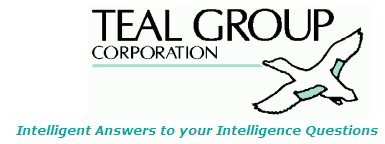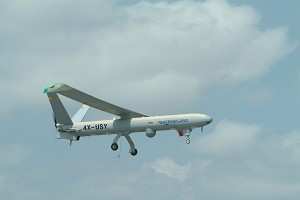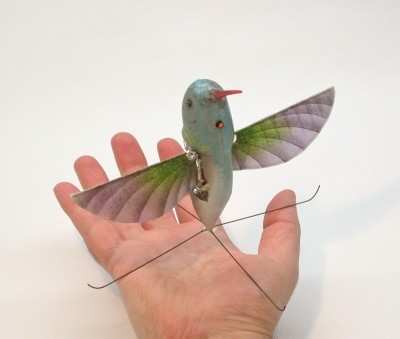Teal Group Says UAV Spending Will Double In The Next 10
Years
Unmanned Aerial Vehicles (UAVs) have been the most dynamic
growth sector of the world aerospace industry this decade, report
Teal analysts in their latest integrated market analysis.

Teal Group's 2011 market study estimates that UAV spending will
almost double over the next decade from current worldwide UAV
expenditures of $5.9 billion annually to $11.3 billion, totaling
just over $94 billion in the next ten years. "The UAV market will
continue to be strong despite cuts in defense spending," said
Philip Finnegan, Teal Group's director of corporate analysis and an
author of the study. "UAVs have proved their value in Iraq and
Afghanistan and will be a high priority for militaries in the
United States and worldwide."
The study suggests that the US will account for 77% of the
worldwide RDT&E spending on UAV technology over the next
decade, and about 69% of the procurement. "We expect that the sales
of UAVs will follow recent patterns of high-tech arms procurement
worldwide, with the Asia-Pacific representing the second largest
market, followed very closely by Europe," said Teal Group senior
analyst Steve Zaloga, another author of the 458-page study. "Africa
and Latin America are expected to continue to be very modest
markets for UAVs."

NASA Predator B
The eighth edition of the sector study, World Unmanned Aerial
Vehicle Systems, Market Profile and Forecast 2011, examines the
worldwide requirements for UAVs, including UAV payloads and
companies, and provides ten-year forecasts by country, region, and
classes of UAVs.
Teal Group analysts already cover the UAV market in their World
Missiles and UAV Briefing, which examines the UAV market on a
program-by-program basis. The sector study examines the UAV
market from a complementary perspective, namely national
requirements, and includes both a comprehensive analysis of UAV
system payloads and key UAV manufacturers.

Elbit Systems Hermes 450 UAV
The 2011 study provides 10-year funding and production forecasts
for a wide range of UAV payloads, including Electro-Optic/Infrared
Sensors (EO/IR), Synthetic Aperture Radars (SARs), SIGINT and EW
Systems, C4I Systems, and CBRN Sensors, worth $2.6 billion in
Fiscal Year 2011 and forecast to increase to $5.6 billion in Fiscal
Year 2020. The UAV electronics market will grow steadily,
with especially fast growth and opportunities continuing in SAR and
SIGINT/EW, according to Dr. David Rockwell, third author of the new
study.
"The payload portion of the 2011 study includes many new systems
and system types, with expanded coverage of SIGINT/EW and SAR
markets," said Rockwell "Few now question the U.S. Air
Force's claim that ISR is 'the centerpiece of our global war on
terrorism, with production beginning for major endurance UAV
systems such as MP-RTIP and ASIP,' new RDT&E programs such as
wide angle EO/IR systems, and a variety of ground and
foliage-penetrating radars, and future development efforts to bring
large-aircraft capabilities to small UAVs; tactical and
mini/micro/nano-UAVs will continue to offer some of the best
electronics opportunities over the next decade."

Nano UAV
The study also includes a UAV Manufacturers Market
Overview that reflects the worldwide UAV market "continuing as one
of the prime areas of growth for defense and aerospace companies,"
said Finnegan. The new study reflects the rapid growth of
interest in the UAV business by increasing the number of companies
covered to some 35 US, European and Israeli companies, and reveals
the fundamental reshaping of the industrial environment.
"Smaller companies can successfully compete against larger
players, as AAI Corp., Insitu, General Atomics and AeroVironment
have all shown," Finnegan said. "Now the prime contractors
are buying the successful smaller companies." In the past
year, L-3 Communications bought Airborne Technologies, a small UAV
developer and manufacturer, and VT Group purchased Evergreen's UAV
fee-for-service operations.
As prime contractors and small companies compete in the dynamic
UAV market, they are adopting widely different strategies.
"Our overview tracks the widely varying approaches being taken by
these key companies, ranging from outright acquisitions to teaming
arrangements and internal development of new UAV systems," said
Finnegan.
 ANN's Daily Aero-Term (04.20.24): Light Gun
ANN's Daily Aero-Term (04.20.24): Light Gun Aero-News: Quote of the Day (04.20.24)
Aero-News: Quote of the Day (04.20.24) ANN's Daily Aero-Linx (04.21.24)
ANN's Daily Aero-Linx (04.21.24) Aero-News: Quote of the Day (04.21.24)
Aero-News: Quote of the Day (04.21.24) ANN's Daily Aero-Term (04.21.24): Aircraft Conflict
ANN's Daily Aero-Term (04.21.24): Aircraft Conflict






